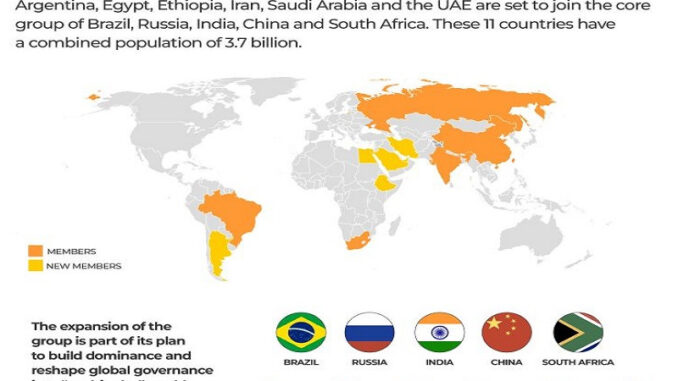
ENB Pub Note: An excellent overview of the BRICS expansion. It is clear that the new members are a solidification of the BRICS Bank and the global financial model changing. The other Geopolitical implications are significant. The new BRICS Block will control over 80% of the oil and gas reserves. This is effectivaly the end of the United States’ abiltiy to weaponize the dollar, and complete the Western cultures falling into decline. I recommending subscribing to Andrew Korybko’s newsletter for a global view not found in mainstream media.
It’s too early to say whether the scenario of BRICS broadly bifurcating into yuan- and non-yuan-using members will come to pass, but it can’t be ruled out since India prefers its own currency for obvious reasons while others are afraid of facing the US’ wrath if they help the yuan replace the dollar. As BRICS enters a new era after its latest expansion, its members must not let their growing differences impede the group’s work on advancing their shared goal of accelerating financial multipolarity processes.
The 15th BRICS Summit ended on Thursday with the organization inviting Argentina, Egypt, Ethiopia, Iran, Saudi Arabia, and the UAE to join as full-fledged members beginning next year. This historic expansion carries with it substance and symbolism, but also pros and cons, all of which will be analyzed in this piece. To begin with, it’s crucial to clarify that formal membership in BRICS isn’t a prerequisite for any given country participating in financial multipolarity processes, but it does help accelerate their efforts.
Any government can decide to prioritize the use of national currencies in bilateral trade, though it’s best for them to coordinate this with the largest number of countries and largest markets possible, hence the primary benefit that formal membership in BRICS brings. These six countries and those that’ll eventually follow in their footsteps have frequent meetings with a wide range of their counterparts’ policymakers throughout the group’s many meetings that are held each year ahead of its annual summit.
All others who’ve yet to obtain this privileged access but are still sincere in their desire to accelerate financial multipolarity processes can likely count on being invited to annual summits from here on out owing to the precedent set by South Africa this year. They’ll probably also be able to formalize some sort of partner relations with BRICS in the coming future too, not to mention already having the opportunity to apply to join the New Development Bank (popularly known as the BRICS Bank).
Bangladesh, Egypt, the UAE, and Uruguay joined the BRICS Five in this institution, but the first and last have yet to become full-fledged members of this group as a whole. Even so, joining the BRICS Bank could possibly become one of the fastest pathways for countries to formally become BRICS members. In any case, the point is that participation in this institution contributes to accelerating any given country’s financial multipolarity plans, especially regarding the use of national currencies in bilateral trade.
Having clarified that, the decision to invite those six previously mentioned countries as full-fledged members will drastically change the group’s dynamics owing to their very different economies and domestic situations. Iran, Saudi Arabia, and the UAE are major energy exporters who could agree to sell their resources in non-dollar-denominated currencies, most likely the yuan (at least to begin with), which could greatly accelerate financial multipolarity processes.
Argentina, Egypt, and Ethiopia, meanwhile, are energy importers and are also experiencing serious economic problems right now. The first is suffering from runaway inflation, the second is propped up by its Gulf patrons, and the third is recovering from the devastating Tigray Conflict. Nevertheless, they’re also important members of their respective regions, with Ethiopia having outsized influence in Africa due to its hosting of the AU headquarters and historical support of Pan-Africanism.
Inviting three members from each of these two very separate categories of countries suggests that the BRICS Five agreed amongst themselves to compromise on economic substance and geographic symbolism correspondingly in order to advance their shared vision of expanding the group this year. The consequence of doing so in this manner, however, is that effective coordination between them is now much more difficult than before owing to their previously mentioned differences.
To be clear, it’s a positive development that a broad range of countries will now participate in BRICS’ countless gatherings each year ahead of its annual summit, but the only thing that they all have in common is their interest in accelerating financial multipolarity processes via their national currencies. That’s not to downplay the importance of BRICS expanding in the way that was ultimately decided upon, but just to inform readers of its newfound limits in order to temper their expectations.
At the same time, BRICS also has more opportunities than before in the sense that more countries can now participate in whatever alternative financial architecture their group unveils in the future such as an inclusive non-Western SWIFT-like payment system. These benefits balance out the obstacles and arguably make the latest move worthwhile in the long term, which is the period that they have in mind, not the short- or medium-terms per se.
Those of their supporters who anticipate the death of the dollar in the very near future will inevitably be disappointed since the BRICS Bank overwhelmingly lends in that currency and only plans to have national ones constitute 30% of its total. Furthermore, BRICS declared before the latest summit that it isn’t interested in de-dollarizing nor in opposing the West, but that it only wants to hedge against forex risks and ensure fairer representation for developing countries in the global financial system.
While some might claim that these goals are identical, the difference lies in the intent, with the false perception risking a Western overreaction that could lead to them waging Hybrid Wars against some members while the correct one reduces those chances. That’s not to say that the second scenario isn’t without its risks, however, since BRICS could still bifurcate even if it’s left to its own with only minimal Western meddling.
To briefly explain, it’s obvious that the yuan will become the preferred non-dollar-denominated currency within BRICS due to its ease of use stemming from all members’ massive trade ties with China. India wouldn’t like that though due to its strategic differences with China, but there might be limited opportunities for using the rupee apart from some symbolic BRICS Bank loans to other members. If faced with the choice of using dollars or yuan to purchase new members’ energy, it’ll likely stick with dollars.
Other members might feel the same as India does despite not sharing its strategic differences with China if they calculate that it’s not worth speeding up the yuan’s replacement of the dollar in non-Western economies out of fear that doing so could provoke the US into making them its next Hybrid War target. Washington can’t pressure everyone at once and destabilize them as punishment for defying its implicit demands, which is why it has to choose its targets wisely.
Prioritizing the use of national currencies that aren’t the yuan isn’t anywhere near as much of a threat to the US’ global financial hegemony as speeding up the yuan’s replacement of the dollar. The first is natural and pragmatic, while the second could easily be perceived by the US as hostile and supposed proof that a government has fallen too far under Chinese influence. Accordingly, the former is unlikely to be chosen as the next Hybrid War target, while the latter will definitely encounter difficulties with time.
It’s too early to say whether the scenario of BRICS broadly bifurcating into yuan- and non-yuan-using members will come to pass, but it can’t be ruled out since India prefers its own currency for obvious reasons while others are afraid of facing the US’ wrath if they help the yuan replace the dollar. As BRICS enters a new era after its latest expansion, its members must not let their growing differences impede the group’s work on advancing their shared goal of accelerating financial multipolarity processes.



